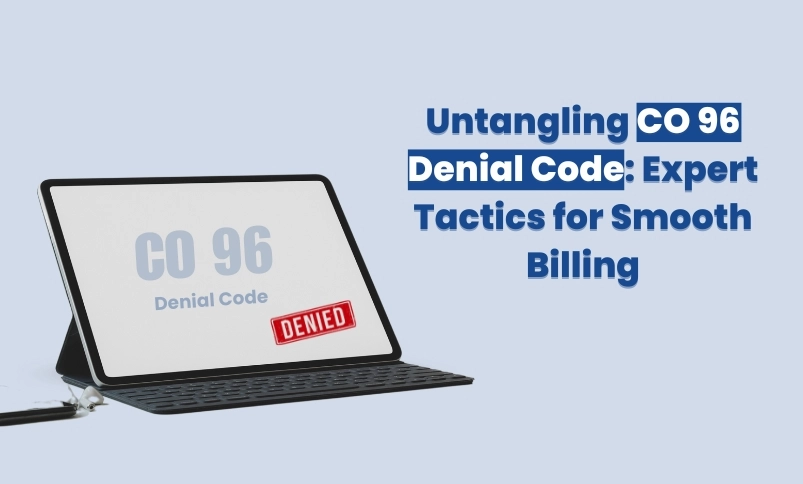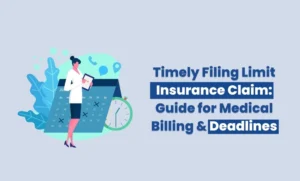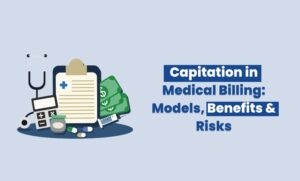In the world of medical billing, denials are an inevitable part of the process. However, understanding the reasons behind these denials is essential for improving the efficiency of the revenue cycle. One such common denial is the CO 96 denial code, which refers to claims that are rejected due to non-covered services.
This seemingly simple denial can actually cause a significant amount of confusion and frustration, especially when healthcare providers are unsure of the underlying reasons or how to resolve them.
What is the CO 96 Denial Code?
The CO 96 denial code is issued by insurance companies when a claim is denied because the service provided is considered non-covered under the patient’s insurance policy.
This means the insurance company will not pay for the service, either because it is outside the scope of the coverage or because it doesn’t meet the plan’s requirements.
For healthcare providers, this often results in the need to either absorb the cost themselves or attempt to appeal the decision with the insurer.
CO 96 is most commonly encountered in Medicare and Medicaid claims, but can also occur with private insurance plans. The key to resolving this denial is understanding why the insurance company has determined the service to be non-covered.
Why Does the CO 96 Denial Code Occur?
CO 96 denials don’t just appear out of nowhere. There are several common reasons why this happens, and understanding these reasons is key to fixing and preventing them.
Here are the top causes for CO 96 denials:

Non-Covered Services
This is the most direct cause for a CO 96 denial. Insurance policies often exclude certain services—such as cosmetic procedures, experimental treatments, or unapproved drugs. If the service provided falls into one of these categories, it’s likely to be deemed non-covered.
Example: A claim for teeth whitening may be denied because it’s considered a cosmetic procedure not covered under most insurance plans.
Incorrect or Missing Codes
Another reason for CO 96 denials is coding errors. If the CPT (Current Procedural Terminology) or ICD-10 codes used in the claim don’t match the service provided or the patient’s condition, the claim may be denied.
Example: Using the wrong ICD-10 code for a routine checkup could lead to a CO 96 denial.
Out-of-Network Providers
If the healthcare provider is out-of-network for the patient’s insurance plan, certain services may not be covered. Insurance companies typically have stricter rules for out-of-network services, leading to CO 96 denials.
Example: A patient seeing an out-of-network specialist for knee surgery could face a CO 96 denial.
Pre-Authorization Issues
Some medical procedures or treatments require pre-authorization from the insurance company. If pre-authorization is not obtained, even if the service is covered, the claim might be denied under CO 96.
Example: If a surgical treatment for a knee injury wasn’t pre-authorized, the insurance company may deny it under CO 96.
Incorrect Patient Information
Sometimes, an error in patient details—such as the wrong insurance policy number or date of birth—can result in a CO 96 denial. This is especially common if the patient’s insurance details don’t match what the insurer has on file.
Example: A claim could be denied because the insurance policy number doesn’t match what the insurer has in their records.
Common Causes of CO 96 Denials
When a healthcare provider receives a CO 96 denial code, it’s crucial to understand the underlying reasons for the rejection. While the code itself signifies that the service is not covered by the insurance plan, there are several specific causes that can lead to this outcome.
Here are the most common causes of CO 96 denials:
| Cause | Description | Example |
| Non-Covered Services | The service provided is not covered by the patient’s insurance plan. | A cosmetic procedure like teeth whitening is considered non-covered by most insurance policies. |
| Incorrect or Missing Coding | Errors in the CPT or ICD-10 codes used for the service. | A claim for a routine checkup uses an incorrect ICD-10 code suggesting a chronic condition. |
| Out-of-Network Providers | Services provided by a healthcare provider that is not in the patient’s network. | A patient seeing an out-of-network specialist for knee surgery has the claim denied under CO 96. |
| Missing Pre-Authorization | Required pre-authorization for specific procedures or services was not obtained. | Surgical treatment for a knee injury was denied because pre-authorization was not requested. |
| Incorrect Patient Information | Errors in the patient’s insurance ID number, policy number, or DOB. | A claim is denied due to an incorrect policy number or mismatched patient details in the insurer’s system. |
How to Fix CO 96 Denial Code
Now that we’ve covered the common causes of CO 96 denials, let’s talk about how to fix them. Addressing CO 96 denials can feel like a challenge, but with the right steps, it’s possible to resolve the issue and ensure smoother billing in the future.

1. Review and Correct the Service Codes
Incorrect coding is a leading cause of CO 96 denials. The first step is to verify that the CPT and ICD-10 codes are accurate and match the services provided and the patient’s condition.
Action Steps:
- Verify the codes: Confirm that the CPT and ICD-10 codes align with the procedure and diagnosis, respectively. Even small errors can lead to a rejection.
- Cross-reference with payer guidelines: Different insurance companies may have varying requirements for the codes they accept. Review the payer’s coding guidelines to ensure compliance.
- Utilize coding tools: Using an electronic claim scrubber or automated coding tool can help identify issues before submission, saving time and reducing errors.
2. Ensure Correct Patient Information
Inaccurate or outdated patient information is another common cause of CO 96 denials. It’s essential to ensure that all details related to the patient, including insurance ID number, policy number, and date of birth, are correct.
Action Steps:
- Verify insurance eligibility before each visit. Many practices use electronic eligibility verification tools that instantly confirm a patient’s coverage status and policy details.
- Ensure accurate demographic data: Double-check that the patient’s name, insurance policy number, and other critical information are correctly entered into your system.
- Check for outdated insurance policies: Sometimes, patients may forget to update their insurance details with your office. A quick verification of the policy before submitting a claim can save you from costly denials.
3. Confirm Pre-Authorization Requirements
Before providing certain services, it’s important to check if pre-authorization is needed. If a service requires pre-authorization and it wasn’t obtained, you can request it from the insurer or file an appeal.
Action Steps:
- Check if pre-authorization is required for the service.
- Request pre-authorization before providing the service.
- If pre-authorization wasn’t obtained, submit an appeal with the insurer to address the oversight.
4. Communicate with the Insurer
When a CO 96 denial occurs, it’s essential to reach out to the insurance company for clarification. Direct communication with the insurer’s claims department can often resolve the issue.
Action Steps:
- Call the insurer’s claims department for a detailed explanation of the denial.
- Request a detailed Explanation of Benefits (EOB) or Remittance Advice.
- Document your communication with the insurer for reference if you need to file an appeal.
5. Submit a Well-Structured Appeal
If the denial can’t be resolved by fixing the initial error, you may need to submit an appeal to the insurer. A well-prepared appeal can lead to a successful resolution.
Action Steps:
- Review the insurance provider’s appeal process and requirements.
- Gather supporting documents, such as medical records, pre-authorization approvals, or a detailed explanation of medical necessity.
- Write a clear, concise appeal letter that outlines the situation and why the service should be covered.
How to Prevent CO 96 Denials
| Proactive Measure | Description | Action Steps |
| Staff Training and Education | Regular training for billing and coding staff on current practices, codes, and payer rules. | -Conduct periodic training on updated coding standards and payer requirements. -Provide access to coding references and payer-specific guidelines. |
| Use of Claim Scrubber Tools | Automated tools that check claims for coding errors or missing information before submission. | -Integrate claim scrubber tools into your billing system. – Run claims through scrubbers to identify errors in real-time. |
| Verify Insurance Eligibility | Ensure insurance coverage and pre-authorization requirements are confirmed before providing services. | -Use real-time eligibility verification tools before each patient visit. – Check if pre-authorization is required and obtain it before proceeding. |
| Accurate Patient Information | Ensure all patient details, including insurance information, are accurate and up-to-date. | -Verify patient insurance info at the time of scheduling or check-in. – Use digital forms to update patient data regularly. |
| Clear Claims Review Process | Implement a standardized review process to catch errors before claims are submitted. | -Develop a claims checklist for reviewing all submissions. – Designate a team to audit claims for accuracy before submission. |
| Robust Appeals Process | Have a clear and efficient system for appealing denied claims quickly. | – Set up an appeals tracking system for denied claims. – Ensure that staff is trained in submitting detailed and accurate appeal letters. |
The Future of CO 96 Denials: How Technology Will Change the Game
In this section, we’ll explore how these technologies are shaping the future of billing and improving the way CO 96 denials are handled.
Artificial Intelligence (AI) and Machine Learning (ML):
- AI and ML are enhancing claims processing by identifying errors before submission.
- These technologies help detect coding mistakes and mismatched patient data, reducing the chances of CO 96 denials.
- Predictive analytics from AI can forecast potential issues and allow providers to take proactive steps.
Real-Time Eligibility Verification:
- Real-time tools allow providers to verify patient insurance coverage instantly, ensuring up-to-date policy details before service.
- These systems also confirm pre-authorization requirements, helping to avoid CO 96 denials caused by coverage issues.
Automation in Claims and Appeals:
- Automated claim submission and tracking systems reduce human error and speed up the billing process.
- Automation enables faster appeals, with customized templates and automated follow-ups, decreasing the administrative burden.
Blockchain for Data Transparency and Security:
- Blockchain technology offers a secure, tamper-proof system for storing claims and insurance data, reducing errors and fraud.
- It ensures greater transparency between providers, insurers, and patients, simplifying the resolution of denials.
Impact on Revenue Cycle Management:
- As these technologies integrate, practices will experience fewer denials, quicker claim resolutions, and improved cash flow.
- The combination of AI, automation, and real-time tools will streamline the entire claims process, enhancing operational efficiency.
Embracing Technology for a Smarter Future
By adopting these innovative solutions, healthcare providers can reduce denials, improve reimbursement timelines, and enhance the patient experience. The future of medical billing lies in harnessing the power of automation, artificial intelligence, and data transparency, all of which will contribute to a smoother, more effective revenue cycle management process.
As these technologies continue to evolve, CO-96 denials will become increasingly easier to handle, ensuring that healthcare providers can focus on what matters most: delivering quality care to their patients.





